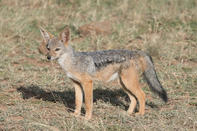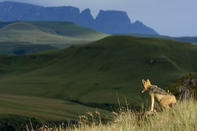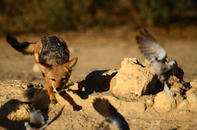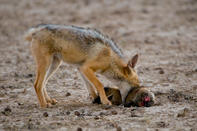
The Black-Backed Jackal looks like a dog. It has a dark white flecked saddle on its back, a black tail and fairly large pointed reddish-backed ears. They can grow up to 40 cm tall, with adult animals weighing between 7 and 10 kg. Their tracks are dog-like, oval-shaped and show nail marks, with the length of the track being longer than the width.
They are nocturnal animals that, depending on the season, may operate on their own or as part of a family. Increased howling from May or June is one of the first signs that they are in breeding mode. They howl less once they start breeding, as to not give away the location of their dens.
Black-backed Jackal

Howls at sunset and sunrise may be close to their resting site, but howls during the rest of the time can be anywhere in their hunting area or on the edge of their home range. During the breeding season, they will become more territorial and even chase pups from previous breeding seasons away.
The females carry the pups for about 63 days, and give birth from August to September. The pups are born in dark, underground dens. The female will stay with the pups during the first three weeks or so, during which the male has to collect food and bring it to the den. Sometimes a young jackal from the previous season will act as helper and also bring food.
The pups are moved to a new den by the time they are about four weeks old. The pups will stay close to the dens until they are old enough to explore with the adults around January, February. Black-backed jackal pups are old enough to explore on their own by March, April. After this, they will stay close to a core area, only using burrows if they need to flee.
Killing and Feeding Pattern

Black-backed jackals usually chase their prey and then bite the animal on the side of its head. There may be clear tooth marks between the ear and the eye of the animals, or the ear of the prey might be torn. Bite marks may also occur on the back of the legs or on udders. They tend to take one animal per kill, with prey ranging from lambs to weak and large sheep and even cows and calves.
A jackal may attack a cow that is lying down to calve and start eating on the calf as it emerges or at the cow’s udder and inside flanks of the hind legs. Their feeding pattern is to start eating at the groin or the stomach, leaving a flap of skin that has been hollowed out underneath.
They will remove the intestines and stomach from the body and eat softer inner parts like the heart, liver and kidneys. The tips of the rib bones may also be chewed off. They generally do not move the carcass from the kill site.
Management

Management should be aimed at the individuals that are causing the damage. Jackal-proof fencing, which is mesh fence about 1,2 m high with 74 mm openings, or electric fencing, noise, light and scent deterrents, guard animals, shepherds and putting livestock in a kraal at night may all help to prevent losses.
Farmers who would like to use night hunting or hunting with dogs to cull damage-causing black-backed jackals need to apply for a permit from their local nature conservation department.